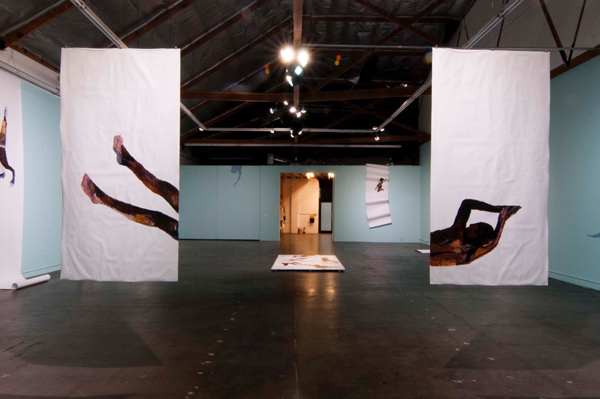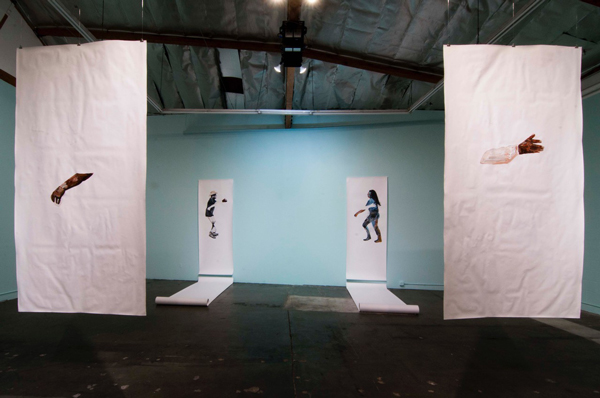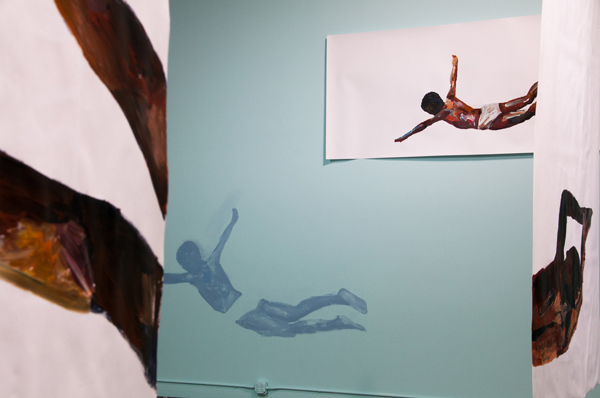Iraqi-born, Los Angeles artist Susu Attar opened an expansive exhibition on October 20th filling LA’s very own The Mistake Room with dynamic paintings made on long scrolls of white paper. Entitled Isthmus, TMR Deputy Director Kris Kuramitsu curated the wonderfully designed installation, and the effort was achieved with support from The Main Museum’s artist in residence program.
Upon entering the large gallery, I was struck by uncanny use of overall space with an economy of means and how it was so mathematically balanced in a room that could have been problematic by its size. Scrolls of paper hung from the high ceilings in the middle of the space, off the perimeter walls, or lay in the middle of the floor—all in precise spots that filled the volume yet assumed a lightness as if large kites were adrift throughout the room. On the scrolls were images of bodies and body parts, painted with raw and ragged energy isolated on the white paper. They floated in the air and captured viewer’s immediate attention with their seeming defiance of gravity for something potentially so emotional and heavy. I felt a brief fleeting reference that a Francis Bacon painting could had exploded into many parts and been captured by the artist in a mystic web of stunning contemporary illogic as Susu enters a new realm entirely with her painting project.
I worked briefly with Susu Attar last summer in Little Tokyo when she was artist in residence at the Little Tokyo Service Center. I was coordinating the larger residency program, and became familiar with some of her work at that time, and we had several discussions about it. Yet the current effort at TMR was my first opportunity to experience a full body of her work created with a clear through line for a solo exhibition. We discussed this work and what it brought up in terms of ideas, images, and context of this moment in time.

Susu Attar, We Echoed a Beautiful Song, 2018, acrylic on canvas. Image: Courtesy of The Mistake Room, Los Angeles.
CC: Isthmus is defined often as a piece of geography, but less commonly as a narrow organ, passage, or piece of tissue connecting two larger parts. How did you come up with the title of your show, and its relation to the body parts that are painted on the sheets of paper hung as scrolls about The Mistake Room?
SA: The Arabic equivalent is actually what inspired it. Barzakh, is not only the geography and the organ, but also the partition between the spirit world and the material world as well as past, present, and future as a whole. What I like about this word is that can be an unseen material (like the uterus), a visible part of earth that contains land, water and the sky above it, and back to the unseen in reference to the spirit world and to time. It can symbolize many things at once.
CC: The press release states that your practice is exploring ways images of embodied subjects circulate in a media saturated world and how this digitized circulation impacts the meaning-making potential of pictures. What exactly do you mean by this? What is an embodied subject in your case and in this show? Are these your images from your photos, or where did they come from, and isolated from their source and put into a context like The Mistake Room in a painterly context, what then happens?
SA: These are bodies that are typical subjects of violence and that are disproportionately subjected to violence. We see this within a multitude of contexts like war, police brutality, or even gender as is the case with women.

Susu Attar: Isthmus, Installation View at The Mistake Room, Los Angeles, CA, 2018. Image: Courtesy of The Mistake Room, Los Angeles.
I’m interested in the narratives that are shaped by media about these bodies, more importantly, these peoples, through images of their bodies. Any group of people whose story is dominated by media narrative are forced to navigate that narrative in their daily lives, and when attempting to tell their own stories. But at that point, you are trying to convince people that you are not what they think you are, and that is virtually impossible. So, the connection between news media and narrative, desensitization and expectation formation, and limits of imagination and limits to progress are all at play here.
These are images from news media that I collect. These particular images come from the US and Iraq. Yes, these are countries I’m from but more importantly, these are the subjects of violence I witness in real life. I remove them from the context of the photograph to emphasize the violence, the lack of context, to focus on the posture of the body and to create a moment of possibility for the meaning of that posture.

Susu Attar: Isthmus, Installation View at The Mistake Room, Los Angeles, CA, 2018. Image: Courtesy of The Mistake Room, Los Angeles.
I was invited by TMR to do a sort of residency in their space for several weeks to experiment with concepts we’d been in conversation about. I started to think of the space as a sort of canvas and the arrangement of the bodies and paper like composing elements on that canvas. The paper has a sculptural quality to them that adds the language of object to the subjects. The subjects are not all the same but they do share some qualities and they share the space. Each painting is an individual piece and a part of the spacial composition, the installation.
The subjects are in the context of violence but are not all directly experiencing violence. For example, playfulness in a war zone or protest against police brutality. It’s a meditation on the postures and the possibilities of their meaning when removed from the context of media and repositioned in space. Then the viewer’s body and the subject’s body are in conversation with one another.
CC: Artists have been challenging the space between photography and painting, but what does that mean to you? What is the challenge anymore and why does it need challenging? Aren’t the two spaces pretty well distinct, or is there something about them that overlaps and needs further exploration?
SA: Painting can suggest reality and fantasy at the same time. Proportions, shapes, and colors, can lead us in and out of the illusion of reality. Photography gives the viewer the sense of seeing reality, the sense that the viewer has witnessed something—without truly witnessing. Ultimately, a photograph is an edited version of reality, and it relies on captions to provide context. Painting is a way to offer the viewer (and the painter) a chance to interpret, to take responsibility for our interpretation, and to allow room for differing interpretations.

Susu Attar: Isthmus, Installation View at The Mistake Room, Los Angeles, CA, 2018. Image: Courtesy of The Mistake Room, Los Angeles.
CC: Your images come from contexts of violence and turmoil, and when isolated does this allow for an empathy, the hoped for meditation or bearing witness you might seek? Can you elaborate on all of this in the spirit of the transformative potential of the artistic gesture, which is mentioned as one of your values?
SA: I hope so. I paint first for myself. To see something, to understand better. For me, the process is most certainly an offering of empathy, of bearing witness to the subject and —in this case—- mourning for them.
I hope that the ambiguity offered in the painting and in the installation create space for interpretation. The transformative potential starts with our imaginations as viewers and extends that possibility to the subjects. I want to imagine humanity as limitless and I want people to imagine themselves that way too. Painting is the language I’m using here to exercise these values for myself, in conversation with myself. That’s the only way I know how to discover what conversation is needed next.

Susu Attar: Isthmus, Installation View at The Mistake Room, Los Angeles, CA, 2018. Image: Courtesy of The Mistake Room, Los Angeles.
After painting these bodies I began to feel the need to mourn for them through the work. The mediums it was calling for at that point were music and movement. What resulted is a collaboration with musicians Sandra Lawson-Ndu and Sheila Govindarajan on an experimental music performance that’s inspired by practices of communal grief. (There will be a performance of this at The Mistake Room on November 14th at 7:30PM)
CC: Is the show linked in any way to the topical, or the socio-political landscape we inhabit in this cultural moment and if so, how would you describe your attention to it as an object maker, a creative person, a person of the world?
SA: Yes. It is the news I am reading as an American about America. That being said, I don’t see it as political work. Now of course, life is political. However, to me, this show is about the spiritual. I observe, experience and contemplate life and I try to take responsibility for what I know. What captures my attention is interconnectivity and imagination. Ultimately, that’s what I’m seeking to explore and exercise through my work.
Isthmus will run through December 8, 2018 at The Mistake Room, 1811 E. 20th Street, Los Angeles, CA, 90058. To contact, 213-747-1200; www.tmr.la
Susu Attar (b. 1982) is a multimedia artist who lives and works in Los Angeles. Her work has been included in exhibitions in Montreal, Mexico City, San Francisco, Dubai, and Minneapolis, among other cities. In 2018, she held two artist residencies in Los Angeles: one at The Main Museum, and the other as one of the inaugural participants in the +LAB Artist Residency through the Little Tokyo Service Center. She was also a finalist for the 2018 Los Angeles Artadia Award. Attar’s practice extends to theatrical production and exhibition curating. Notably, she is a member of the SEPIA Collective, a women of color art collective whose work includes a traveling exhibition, ICONIC: Black Panther, in which artists respond to the legacy of the Black Panther Party. She has also co-produced and designed Haram, an experimental theatrical production inspired by the poetry of Dr. Maher Hathout. She holds a BA from San Francisco State University in Painting and Conceptual Information Art.
Clayton Campbell is an artist, writer and cultural producer based in Los Angeles, working locally, nationally and internationally. www.claytoncampbell.com , claytoncampbellconsulting.com


















0 Comments